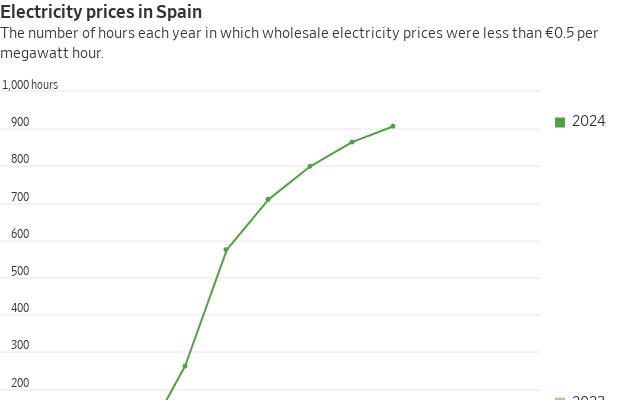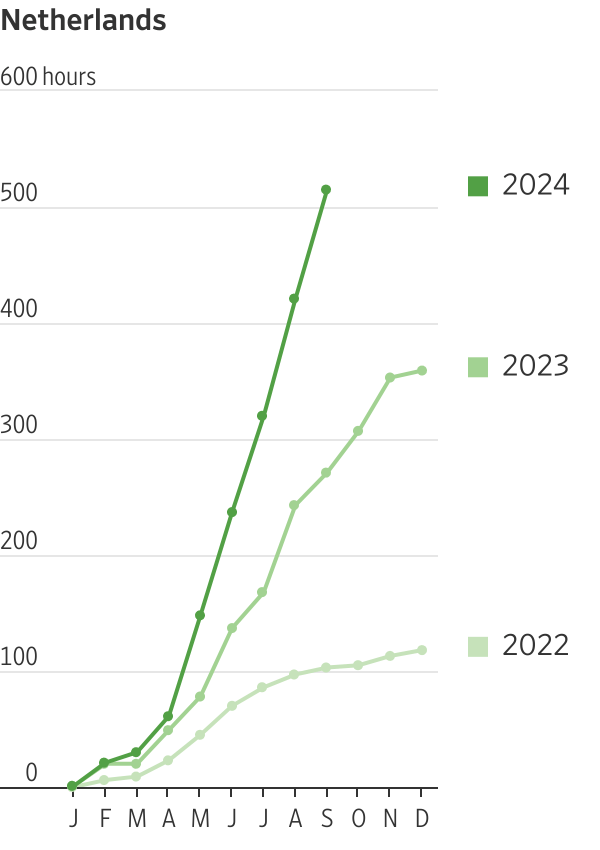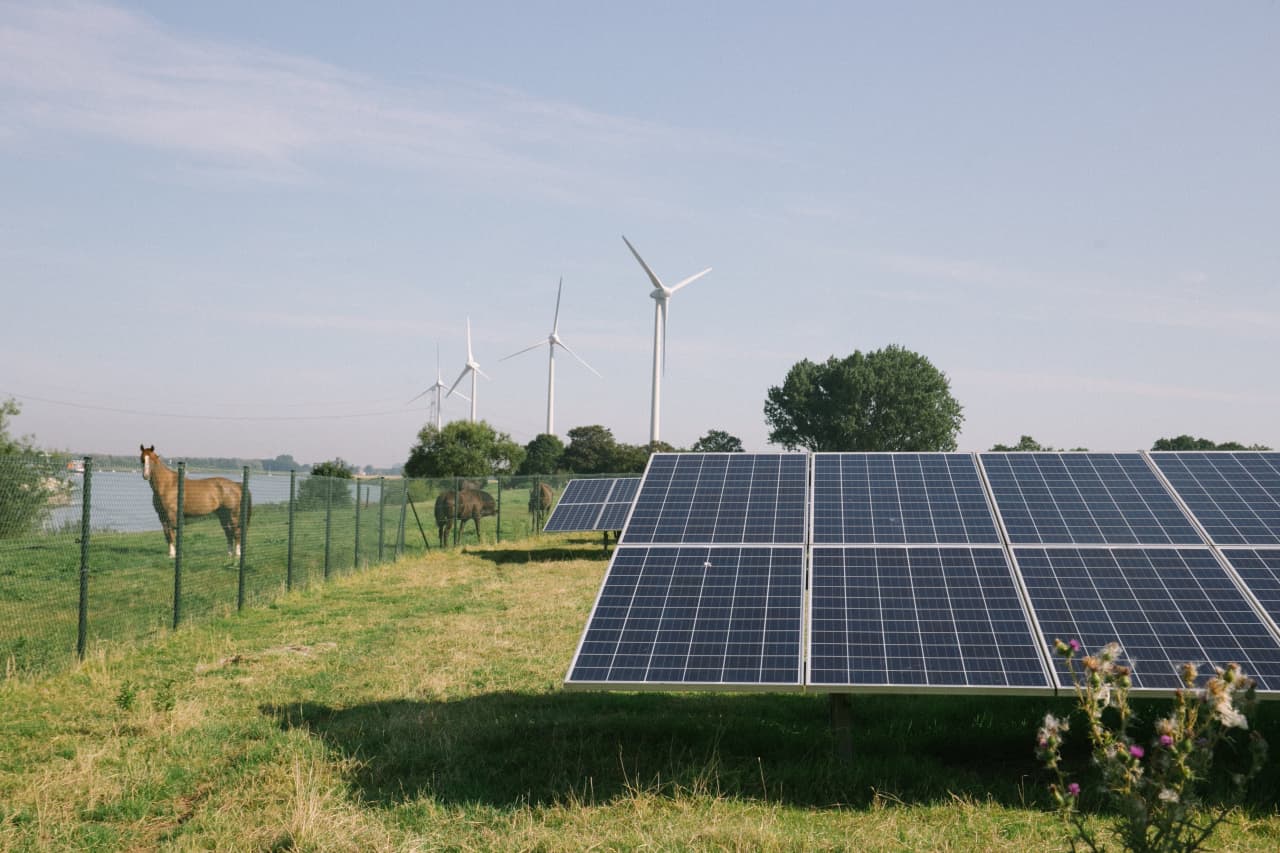Electricity That Costs Nothing—or Even Less? It’s Happening More and More
A surge in wind and solar power means many businesses and consumers around Europe can get paid for plugging in. The U.S. could be next.
KERKDRIEL, the Netherlands—For much of the spring and summer, Jeroen van Diesen got paid for using electricity.
Sometimes his neighbours came over to power up too, generating even more cash.
Van Diesen’s situation reflects the strange, new dynamics of electricity that could soon become the norm in many parts of the world: A big increase in wind and solar power has pushed wholesale prices to zero or below for many hours of the year, spurring a sea change in the way people use power—based on whether the sun is shining or the wind is blowing.
Most people pay a fixed price for each kilowatt-hour of electricity they consume throughout the day. The price is set by their power company and only changes at infrequent intervals—once a week, a month or even only once a year.
Van Diesen, a software salesman, recently signed up to receive electricity from two providers that charge him the hourly price on the Dutch wholesale power market, rather than a fixed price that resets monthly or annually. When the price of electricity falls low enough, smart meters in his house begin charging his two electric cars.
Wholesale prices swing wildly each hour of the day, and even more so as a larger share of electricity flows from wind and solar installations. Because the generation costs of wind or solar farms are negligible, market prices will be near zero when there is enough renewable power to cover most of a region’s electricity demand.
Electricity market dynamics get weirder when renewable-energy producers don’t have an incentive to stop feeding power into the grid, usually because of government subsidies. Then grids can be flooded with excess power, pushing prices into negative territory.
Van Diesen said he’s made 30 euros, equivalent to around $34, over the past five months charging his car, enough to cover the service fee from his power supplier, a Norwegian company called Tibber.
“I’m charging the car for free,” said van Diesen, who is part of a group of clean-energy enthusiasts in the Netherlands who call themselves green nerds. “To me it’s also like a hobby and a game—how far can I go?”
Doing laundry in the evening? The electricity could be free a few hours later when demand dies down and the wind picks up. Likewise, in regions with lots of solar power, charging an electric vehicle in the morning is usually far more expensive than powering up under the midday sun—or whenever the price is right.
In the U.S., most states don’t currently allow such real-time pricing, but many think that will change. Already, in some of the world’s biggest economies from Western Europe to California, the occurrence of zero and negative wholesale power prices is growing fast.
Negative prices
Wholesale prices across continental Europe have fallen to zero or below in 6% of all hours this year, up sharply from 2.2% in 2023 and just 0.3% in 2022, according to data collected by Entso-E, the group of European transmission system operators. In markets with lots of renewable capacity, this year’s figure was higher: 8% in the Netherlands, 11% in Finland and 12% in Spain. Analysts expect those numbers will grow as more solar panels and wind turbines are installed.
The changes sweeping Europe’s electricity markets, which were accelerated by the energy crisis brought on by the war in Ukraine, show what could happen in the U.S. in a few years when renewable capacity reaches a similar scale. In 2023, 44% of EU electricity was generated by renewables, compared with 21% in the U.S.
In some U.S. markets—sunny California, the wind-swept Great Plains, and Texas—zero and negative prices are already common. The wholesale price in Southern California was negative nearly 20% of all hours this year because of the region’s boom in solar-panel installations. That compares to around 5% last year, according to data collected by the U.S. Energy Information Administration.
U.S. regulators have been cautious about allowing households and companies to sign up for electricity plans that charge them wholesale prices, fearing consumers could be hit with big bills if prices jump. Texas consumers who signed such contracts were walloped with huge bills in 2021 when a rare winter storm sent prices soaring.



States’ reluctance, however, may now be waning as policymakers increasingly see real-time pricing as a way to lower peak demand, reduce the need for costly infrastructure and integrate more renewables into the grid.
California regulators this year ordered the state’s utilities to expand dynamic price pilot programs that have only been available for a select group of customers.
Your overall power bill still won’t be zero in a clean-energy future. Generation costs comprised around 60% of customer bills on average in the U.S. in 2023. Transmission and distribution costs account for most of the rest—and are expected to grow sharply in the coming decade to reinforce the grid for electric heating, electric transport and data centers.
Negative prices could also be reined in over the next few years as governments from Europe to California pare back renewable-energy subsidies. Governments are particularly focused on trimming subsidies for solar power, which is driving negative prices in a number of markets.
Green nerds
In Europe, energy-hungry manufacturers are shifting their operating strategies to maximise energy consumption when prices are close to zero or negative, while throttling back when prices are high.
Linde, a U.K.-based engineering company, is building a new generation of industrial gas plants that can be quickly ramped up and down depending on the wholesale price of power.
When solar and wind power drive prices down, Linde’s plants fire up and send the output to large tanks. When electricity prices shoot up again, the plants can ramp back down and supply customers out of the gases stored in the tanks.
“The tank functions like a virtual battery,” said Klaus Ohlig, a research and development executive at Linde Engineering.
Trimet, an aluminium producer that is one of Germany’s single-largest power consumers, is overhauling its smelters to vary their power consumption depending on the availability of renewable energy on the grid.
A new European Union law requires dynamic-price power contracts be made available to consumers across the 27-nation bloc. Tibber, a power retailer based in Norway that charges its customers the wholesale hourly price, has signed up more than one million households across the Nordic countries, Germany and the Netherlands.
Edgeir Aksnes, Tibber’s co-founder and chief executive, says he doesn’t expect customers to constantly track the hourly price before deciding when to charge their car or run appliances.
“We can automate all of this for you. You don’t have to think about it,” he said.
Some enthusiasts, however, like to get into the weeds.
Wouter van Embden, a 49-year-old Dutch entrepreneur and one of the country’s so-called green nerds, switched to Tibber earlier this year. On a recent summer Sunday, the battery in his home began charging as solar power flooded the Dutch grid and the wholesale power price fell to zero. He also charged his two electric cars and programmed his heat pump to make the water in the house tank extra hot.
Toward the evening, as prices rose with the drop-off in solar, van Embden’s battery—which he and his son built at home—would power his home as well as feed into the Dutch grid.
“I have to be honest, when I started building the battery I had so many outages. There was a lot of testing to do,” he said. “But now it’s working pretty stable.”
 Copyright 2020, Dow Jones & Company, Inc. All Rights Reserved Worldwide. LEARN MORE
Copyright 2020, Dow Jones & Company, Inc. All Rights Reserved Worldwide. LEARN MORE
A divide has opened in the tech job market between those with artificial-intelligence skills and everyone else.
A 30-metre masterpiece unveiled in Monaco brings Lamborghini’s supercar drama to the high seas, powered by 7,600 horsepower and unmistakable Italian design.
A divide has opened in the tech job market between those with artificial-intelligence skills and everyone else.
There has rarely, if ever, been so much tech talent available in the job market. Yet many tech companies say good help is hard to find.
What gives?
U.S. colleges more than doubled the number of computer-science degrees awarded from 2013 to 2022, according to federal data. Then came round after round of layoffs at Google, Meta, Amazon, and others.
The Bureau of Labor Statistics predicts businesses will employ 6% fewer computer programmers in 2034 than they did last year.
All of this should, in theory, mean there is an ample supply of eager, capable engineers ready for hire.
But in their feverish pursuit of artificial-intelligence supremacy, employers say there aren’t enough people with the most in-demand skills. The few perceived as AI savants can command multimillion-dollar pay packages. On a second tier of AI savvy, workers can rake in close to $1 million a year .
Landing a job is tough for most everyone else.
Frustrated job seekers contend businesses could expand the AI talent pipeline with a little imagination. The argument is companies should accept that relatively few people have AI-specific experience because the technology is so new. They ought to focus on identifying candidates with transferable skills and let those people learn on the job.
Often, though, companies seem to hold out for dream candidates with deep backgrounds in machine learning. Many AI-related roles go unfilled for weeks or months—or get taken off job boards only to be reposted soon after.
Playing a different game
It is difficult to define what makes an AI all-star, but I’m sorry to report that it’s probably not whatever you’re doing.
Maybe you’re learning how to work more efficiently with the aid of ChatGPT and its robotic brethren. Perhaps you’re taking one of those innumerable AI certificate courses.
You might as well be playing pickup basketball at your local YMCA in hopes of being signed by the Los Angeles Lakers. The AI minds that companies truly covet are almost as rare as professional athletes.
“We’re talking about hundreds of people in the world, at the most,” says Cristóbal Valenzuela, chief executive of Runway, which makes AI image and video tools.
He describes it like this: Picture an AI model as a machine with 1,000 dials. The goal is to train the machine to detect patterns and predict outcomes. To do this, you have to feed it reams of data and know which dials to adjust—and by how much.
The universe of people with the right touch is confined to those with uncanny intuition, genius-level smarts or the foresight (possibly luck) to go into AI many years ago, before it was all the rage.
As a venture-backed startup with about 120 employees, Runway doesn’t necessarily vie with Silicon Valley giants for the AI job market’s version of LeBron James. But when I spoke with Valenzuela recently, his company was advertising base salaries of up to $440,000 for an engineering manager and $490,000 for a director of machine learning.
A job listing like one of these might attract 2,000 applicants in a week, Valenzuela says, and there is a decent chance he won’t pick any of them. A lot of people who claim to be AI literate merely produce “workslop”—generic, low-quality material. He spends a lot of time reading academic journals and browsing GitHub portfolios, and recruiting people whose work impresses him.
In addition to an uncommon skill set, companies trying to win in the hypercompetitive AI arena are scouting for commitment bordering on fanaticism .
Daniel Park is seeking three new members for his nine-person startup. He says he will wait a year or longer if that’s what it takes to fill roles with advertised base salaries of up to $500,000.
He’s looking for “prodigies” willing to work seven days a week. Much of the team lives together in a six-bedroom house in San Francisco.
If this sounds like a lonely existence, Park’s team members may be able to solve their own problem. His company, Pickle, aims to develop personalised AI companions akin to Tony Stark’s Jarvis in “Iron Man.”
Overlooked
James Strawn wasn’t an AI early adopter, and the father of two teenagers doesn’t want to sacrifice his personal life for a job. He is beginning to wonder whether there is still a place for people like him in the tech sector.
He was laid off over the summer after 25 years at Adobe , where he was a senior software quality-assurance engineer. Strawn, 55, started as a contractor and recalls his hiring as a leap of faith by the company.
He had been an artist and graphic designer. The managers who interviewed him figured he could use that background to help make Illustrator and other Adobe software more user-friendly.
Looking for work now, he doesn’t see the same willingness by companies to take a chance on someone whose résumé isn’t a perfect match to the job description. He’s had one interview since his layoff.
“I always thought my years of experience at a high-profile company would at least be enough to get me interviews where I could explain how I could contribute,” says Strawn, who is taking foundational AI courses. “It’s just not like that.”
The trouble for people starting out in AI—whether recent grads or job switchers like Strawn—is that companies see them as a dime a dozen.
“There’s this AI arms race, and the fact of the matter is entry-level people aren’t going to help you win it,” says Matt Massucci, CEO of the tech recruiting firm Hirewell. “There’s this concept of the 10x engineer—the one engineer who can do the work of 10. That’s what companies are really leaning into and paying for.”
He adds that companies can automate some low-level engineering tasks, which frees up more money to throw at high-end talent.
It’s a dynamic that creates a few handsomely paid haves and a lot more have-nots.
A cluster of century-old warehouses beneath the Harbour Bridge has been transformed into a modern workplace hub, now home to more than 100 businesses.
From Italy’s $93,000-a-night villas to a $20,000 Bowral château, a new global ranking showcases the priciest Airbnbs available in 2026.























